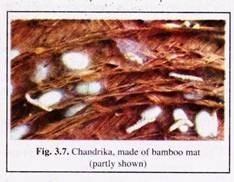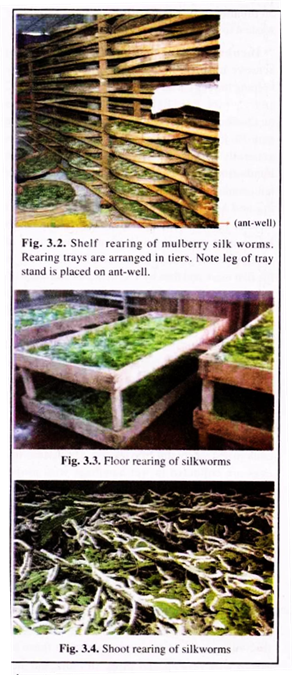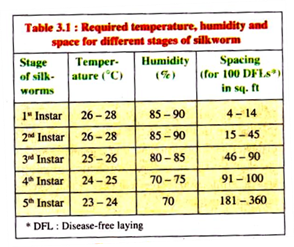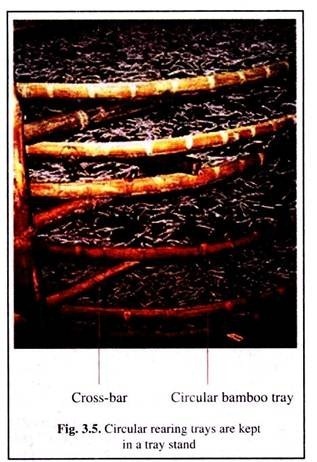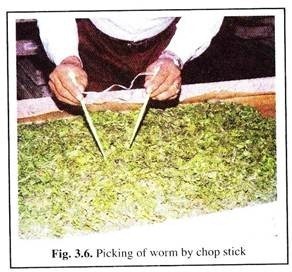In this article we will discuss about the management of egg, larvae and cocoons of silkworm.
Management of Eggs of Silkmoth:
The most important as well as precarious stage of sericulture is the production of healthy and disease-free eggs and it plays a vital role on which the success of the industry depends. Silkworm eggs are also called seeds and for sericulture purpose the eggs are classified into two groups, viz., Reproductive seed and Industrial/Commercial seed.
Reproductive Seed:
The seeds from which parents of different commercial seeds are produced. These are usually pure line of both local and high yielding races and rarely F1 hybrid.
ADVERTISEMENTS:
Industrial/ Commercial Seeds:
These are mostly F1 hybrids, produced by crossing between local hardy pureline female race and pure- line high yielding bivoltine (generally) males.
Egg/Seed Production Centre of Silkmoth::
(1) Breeding Stations:
ADVERTISEMENTS:
For maintaining racial purity, quality and disease-freeness etc., reproductive seeds are produced as well as multiplicated in number in a series of breeding centre called Breeding Stations.
(2) Breeding Centre:
The number of pure breed parents required for a grainage are too large and that cannot be obtained by a single multiplication step from the stock. So generally, a 3 or 4-stage multiplication is carried out to maintain the racial purity as well as to produce quality eggs by technically qualified personnel in a series of breeding centers in the Breeding stations like P4, P3, P2 and P1.
In India, usually 3 Tier system of seed production at P3, P2, and PI level is adopted as follows: P4/P3 (Breeding centres) — Centres where great grandparents or the great grandparents of commercial grainage seeds are multiplied.
ADVERTISEMENTS:
They rear only pure breeds and no hybridisation is done here to maintain the purity of races. So each laying of each race is reared separately in different trays. These are the major germ- plasm bank and seeds produced here are called Basic or Nucleus seed (Breeder’s Stock Egg).
P2 (Breeding Centres) – They receive seed cocoons from P4/P3 centres, so they rear the grandparents of commercial seeds and produce the Foundation Stock Seeds that also serve as germplasm bank. PI (Breeding Centres) – Here the parents of commercial layings are reared.
They receive the seed cocoons from P2 centres. The first hybridisation of double crosses is done here and the hybrids produced are called Foundation hybrids
(3) Grainage:
The establishments where the disease-free commercial seeds are produced in mass to be supplied to rearers are called Grainages. These are mostly owned by Government and may also be licensed private owned.
In grainages parental seed cocoons received from PI centres are reared as well as preserved under optimum conditions. The sexes of either larvae or pupae are recognised and accordingly male and females are reared separately. Following their emergence, healthy adult male and female moths are allowed to mate and oviposit by different methods.
Egg/Seed Production Methods:
In grainages commercial eggs are produced by any of the following methods:
(a) Cellular Bag Method:
ADVERTISEMENTS:
Each pairing moth is kept into a small bag of perforated parchment/paraffin paper or cloth where the female lays eggs. Mother moths are examined after oviposition for pebrine.
(b) Cellular Card Method:
Here, a card or craft paper is divided into 20 cellules or squares in 4 rows, each with 5 compartments. A moth funnel plate with 20 similar holes is placed on that paper. In each section of the hole, one coupling pair of moth is kept and covered by moth funnel.
After egg laying, mother moths are removed and placed in an exact chamber of mother moth box with similar compartments. Then the moths are examined for pebrine. Diseased moth (if detected) and its eggs are discarded. This method can produce eggs in large scale.
(c) Flat Card Method:
In this system, about 40 pairs of coupling moths are allowed to lay eggs on the rough surface of a flat card (Fig. 3.1). If pebrine is detected in any mother moth, all eggs are discarded.
(d) Loose Eggs Method:
Same as flat card method except that eggs are laid on smooth surface of paper. Healthy eggs are then loosened from the paper by soaking it in water. Unfertilised eggs which float on water are discarded. Healthy eggs are washed in water, dried and packed.
Eggs prepared by any method are treated with 2% formalin solution for disinfection. Mother moths after egg laying are also checked for the transovarial infection of pebrine spores. If infection is detected, eggs of that layer are rejected immediately.
Storage of Eggs of Silkmoth:
Silk moths lay two types of eggs
(i) Diapausing or hibernating eggs and
(ii) Non- diapausing or non-hibernating eggs. The eggs are laid either in spring or in autumn.
Storage of Spring Eggs:
Spring eggs are stored at aestivation temperature (23-25°C) from June to August, then at room temperature till September or early October; then gradually lowered to 5°C in December for 50-60 days. This treatment awakens the embryo but arrests the development.
The eggs are kept still at lower temperature (2.5°C) for another 40-50 days where these can also be stored for any length of time. Otherwise, in March, eggs are shifted at a temperature of .10- I5°C for 4-5 days before incubation.
Storage of Autumn Eggs:
Eggs laid in autumn (August) are kept at 23-25°C for 20 days; then the temperature is gradually lowered (to 2.5°C) as for spring eggs till natural temperature is reached.
Artificial Breakage of Diapause:
In order to utilise available mulberry leaves, sometimes hibernating eggs are treated with diluted acid to break their diapause and to get more crops, Eggs are either kept in hot HC1 acid at 25°C for 20-24 hours after oviposition o in dilute acid heated to 46°C for 5 minutes. Sometimes eggs are dipped in HCI at 15°C for about 50 minutes. After acid treatment, eggs should be washed in water.
Incubation of Silkmoth:
Incubation of eggs is done to achieve uniform hatching on a desired day by keeping the eggs at an optimum temperature of 25°C and 75-80% RH (Relative Humidity). Prior to incubation, eggs should be disinfected by treating with 2% formalin.
Three methods of incubations are generally followed:
(i) Constant temperature incubation where eggs are incubated at a constant temperature of 23-25°C till hatching. Non-hibernating and acid-treated eggs are incubated by this method.
(ii) Raised temperature incubation where hibernating eggs are first kept at a temperature of 15°C, which is gradually increased by 0.5°C /day in the first week and then by 1 °C in the second week till the temperature is reached to 27°C where the eggs are kept till hatching.
(iii) Embryonic method of incubation where the eggs are kept during diapause at 15°C and then at 22-23°C till the revolution and then at 27°C till hatching. The incubation period varies with the races, voltinism and incubation temperature.
Transportation of Silkmoth Eggs:
The transportation of eggs plays an important role in the development of embryo and successful crop harvest. The disease-free eggs are collected in wet handbags with proper aeration in early morning or in late evening. Transportation may be done during aestivation period, hibernation or post-hibernation period or pre-incubation period.
Management of Silkworm/Larvae:
Being delicate and domesticated creatures, B. mori larvae cannot tolerate any environmental fluctuations. So in sericulture practice these are reared with very special cares.
In India, the most common method of silkworm rearing is Shelf Rearing Method, where worms are reared (feeding, cocooning, etc.) on trays that are arranged one above the other in tiers held by rearing stand, so that a large number of worms can be reared at a time in a small place (Fig. 3.2).
Other rearing methods include floor rearing that is carried out on fixed rearing seats arranged in 2/3 tiers kept on the floor of rearing house (Fig. 3.3); Shoot rearing where silkworms are also reared in fixed platform kept indoor or outdoor and fed with mulberry branches or shoots (Fig. 3.4).
Rearing Appliances of Silkworm:
Being a rural-based agro-industry, appliances used in sericulture are mostly made of cheap and locally available materials and thus, vary from place to place. Moreover, researchers of CSB and other private rearers have developed many devices suitable for silkworm rearing. Here, appliances, required for shelf rearing, will be mentioned.
Shelf Rearing Appliances:
(i) Tray stand:
This bamboo-made or wooden stand is used to support the rearing trays (Fig. 3.5). It has a height of 2.5 m and has 10-12 cross-bars at a distance of 0-1.5 m to accommodate 10-12 tiers of rearing tray.
(ii) Rearing trays:
These are circular bamboo trays (138 cm dia x 6.5 cm depth) (Fig. 3.5) or light wooden rectangular trays (0.7-0.9 m x 0.9-1.2 m), each of which can accommodate a large number of young larvae. The trays are often coated with cow- dung paste mixed with formalin, though this practice often invites many disease-causing agents.
(iii) Ant wells:
Enamel / Aluminum bowl or stone / concrete blocks (Fig. 3.2) are used as ant wells which are kept filled with water except the central elevation on which legs of tray stands are placed. It prevents ants from crawling up the stand and harming the worms.
(iv) Paraffin paper:
To avoid evaporation of moisture and keep humidity on the rearing tray, pad of paraffin-coated papers are kept on rearing bed of young silkworm. Polythene sheets, dried banana leaves may also be used instead of paraffin-paper.
(v) Foam rubber strips:
To maintain the required humidity, sometimes thick foam pads soaked in water are placed all around the bed. Thick folding of newsprint paper or blotting paper soaked in water can also be used in place of foam strips.
(vi) Chop sticks:
Forcep-like device, made of two thin bamboo sticks, joined at one end by thread is used to pick worms (Fig. 3.6).
(vii) Feather:
Soft, white feathers are used for brushing newly hatched larvae from the egg card to rearing tray and to spread the young worms during spacing.
Management of Cocoons:
1. Harvesting of Cocoons:
Silkworms complete spinning in 2-4 days depending upon the race and climatic conditions provided. Harvesting or collection of mature cocoons must be done after the pupal cuticle has hardened and before the adult emerges.
The recommended time of harvesting is fifth day of spinning for tropical races and seventh or eighth day for temperate races. Cocoons are harvested generally by hand. In advanced temperate country like Japan, simple devices are used for harvesting the cocoons from rotary mountages.
2. Marketing of Cocoons:
Being an alive and also perishable commodity, cocoons should be marketed as early as possible after harvesting and before the moths emerge from them. Defective cocoons have no market value as most of them are not reelable.
These include double cocoon, immature or premature and fragile cocoons, unsized or malformed cocoons, mute (with dead pupa sticking to inner shell) or black-stained cocoons, calcified cocoons, spotted and fungi-attacked cocoons and cocoons with thin middle part or thin ends.
3. Transport of Cocoons:
During transportation cocoons are kept in perforated containers with enough aeration. The containers are so designed to prevent jolting and crushing of cocoons. The transport should be done quickly and for short distance.
4. Cocoon Market:
To keep the price of cocoon uniform and moderate, all state Governments have set up centralised marketing federations. They fix the floor price of cocoons and also formulate guidelines for cocoon transactions.
5. Commercial Characters of Cocoons:
The price structure of cocoons depends on the following physical properties:
(i) Colour:
Commercially bright-coloured cocoons are preferred than dull colour.
(ii) Shape:
Spherical, oval and moderately constricted cocoons are preferred for their easy reelability.
(iii) Size:
Large-sized cocoons can be reeled easily than the smaller one.
(iv) Compactness:
A tight-built cocoon has good reelability.
(v) Grains or Wrinkles:
Cocoons with grains or wrinkles on surface have high demand because of easy reelability.
(vi) Weight:
Cocoons have optimum weight in the middle pupal period. So if sold in this stage can get maximum returns.
(vii) Shell Ratio:
Shell ratio is expressed as under:
For commercial purpose, the ratio should be in the range of 18-20% for bivoltine race.
(viii) Non-breakable Filament Length (NBFL):
Cocoon whose filament can be unwound without any break has best commercial value.
(ix) Filament Denier:
Denier is the unit used to express the thickness of silk filament. It is calculated by the formula given below:
Commercially approved denier varies from 1.7 to 2.8 g.
(x) Renditta:
Number of kilograms of cocoons required for 1 kg of reeled silk is called renditta. Multivoltine has higher renditta than bivoltine races.
(xi) Reelability:
The ratio of unbroken filament to the whole filament length in percentage is the reelability. Multivoltine has poor reelability than bivoltine.

